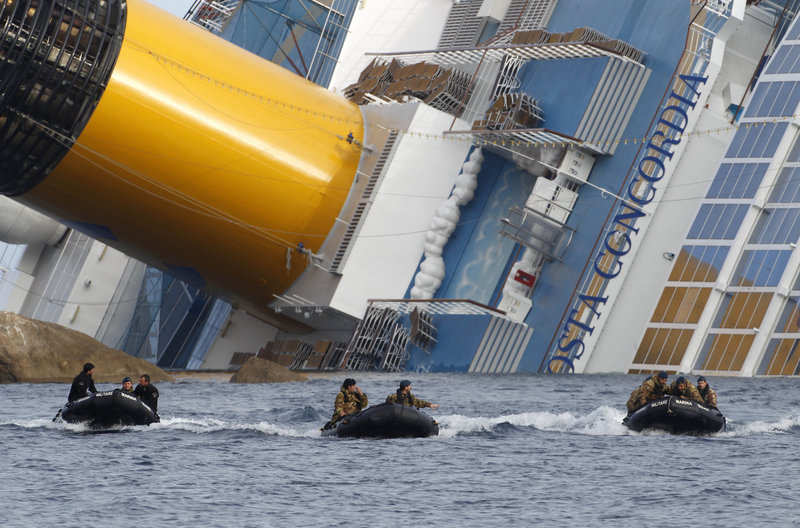ROME — Nudged gently by the tides off Tuscany, the capsized Costa Concordia has been deemed stable enough on its rocky perch for salvagers to begin pumping fuel oil from its giant tanks as early as today.
The cruise liner, its hull gashed by a reef and pocked by holes blasted by divers searching for the missing, yielded two more bodies Monday, 10 days after the accident. The corpses of two women were found in the luxury liner’s Internet cafe, now 55 feet underwater.
Tables, desks, elegant upholstered armchairs and cabinets bobbed in the sea as divers guided the furniture out of the holes to clear space for their exploration inside.
So far, the bodies of 15 people have been found, most of them in the submerged portion of the vessel, while 17 others remain unaccounted for. Authorities said earlier reports that an unregistered Hungarian woman had called friends from the ship before it flipped over turned out to be groundless.
The Concordia rammed a reef and capsized Jan. 13 off the tiny Tuscan island of Giglio as it was carrying 4,200 passengers and crew on a Mediterranean cruise.
Salvage experts received the green light Monday to start pumping fuel soon from the double-lined tanks of the Concordia. The weekslong fuel-removal operation aims to avert a possible environmental catastrophe in the waters off Giglio, part of a protected seven-island marine park.
Officials said the pumping would be carried out as divers continue the search for the missing, since instrument readings have determined the Concordia was not at risk of sliding into deeper waters and being swallowed by the sea.
“The ship is stable,” said Franco Gabrielli, head of the national civil protection agency. “There is no problem or danger that it is about to drop onto a much lower seabed.”
Meanwhile, an oily film was spotted about 300 yards from the capsized vessel by officials flying in a helicopter and by residents of Giglio, Gabrielli’s office said. Samples were being analyzed, but preliminary observations indicated the slick is a light oil and not from heavy fuel inside the Concordia’s tanks.
Absorbent panels put around the area seem to have at least partially absorbed the oil, authorities said.
The ship’s Italian captain, Francesco Schettino, is under house arrest near Naples, facing possible charges of manslaughter, causing a shipwreck and abandoning his vessel while some people were still aboard. He has insisted that he was coordinating rescue operations from a lifeboat and then from shore.
The ship’s operator, Costa Crociere SpA, has distanced itself from the captain, contending he made an unauthorized detour from the ship’s authorized route. Schettino, however, has reportedly told investigators that Costa officials requested that he sail close to Giglio in a publicity move.
In a statement issued late Monday, Costa said it would refund passengers the full cost of the cruise and reimburse all travel and any medical expenses incurred as a result of the accident.
Schettino’s lawyer, Bruno Leporatti, told reporters Monday that tests on urine and hair samples showed his client was not under the influence of alcohol or drugs before the crash. Prosecutors are not allowed to discuss the investigation while it is under way, and it was impossible to confirm the report.
Despite earlier fears, officials said the crippled cruise ship, with a 230-foot gash in its hull, is not expected to roll off its rocky seabed perch and be swallowed by the sea.
An Italian geologist on Giglio monitoring the ship’s movements said the Concordia was not so much moving as “responding to the tides.”
Islanders have been pressing for removal of the heavy, tar-like fuel from the ship’s 17 tanks to avert a possible catastrophic leak.
“They should start the oil drainage operations on the ship. At this point those who died will not come back to life. Even if they pull them out later, unfortunately it won’t make a difference,” Giglio resident Andrea Ginanneschi told The Associated Press.
Five miles of oil barriers have been laid to protect marine life and the pristine waters, which are prime fishing grounds and a protected area for dolphins and whales.
Recovery experts from the Dutch salvage company Smit have said they will create holes in the top and the bottom of each tank, heating the fuel so it flows more easily and pumping from the top while forcing air in from the bottom.
Seven bodies still await identification. Gabrielli said officials have DNA from the relatives of all of the missing passengers and are working to confirm their names.
Send questions/comments to the editors.



Success. Please wait for the page to reload. If the page does not reload within 5 seconds, please refresh the page.
Enter your email and password to access comments.
Hi, to comment on stories you must . This profile is in addition to your subscription and website login.
Already have a commenting profile? .
Invalid username/password.
Please check your email to confirm and complete your registration.
Only subscribers are eligible to post comments. Please subscribe or login first for digital access. Here’s why.
Use the form below to reset your password. When you've submitted your account email, we will send an email with a reset code.